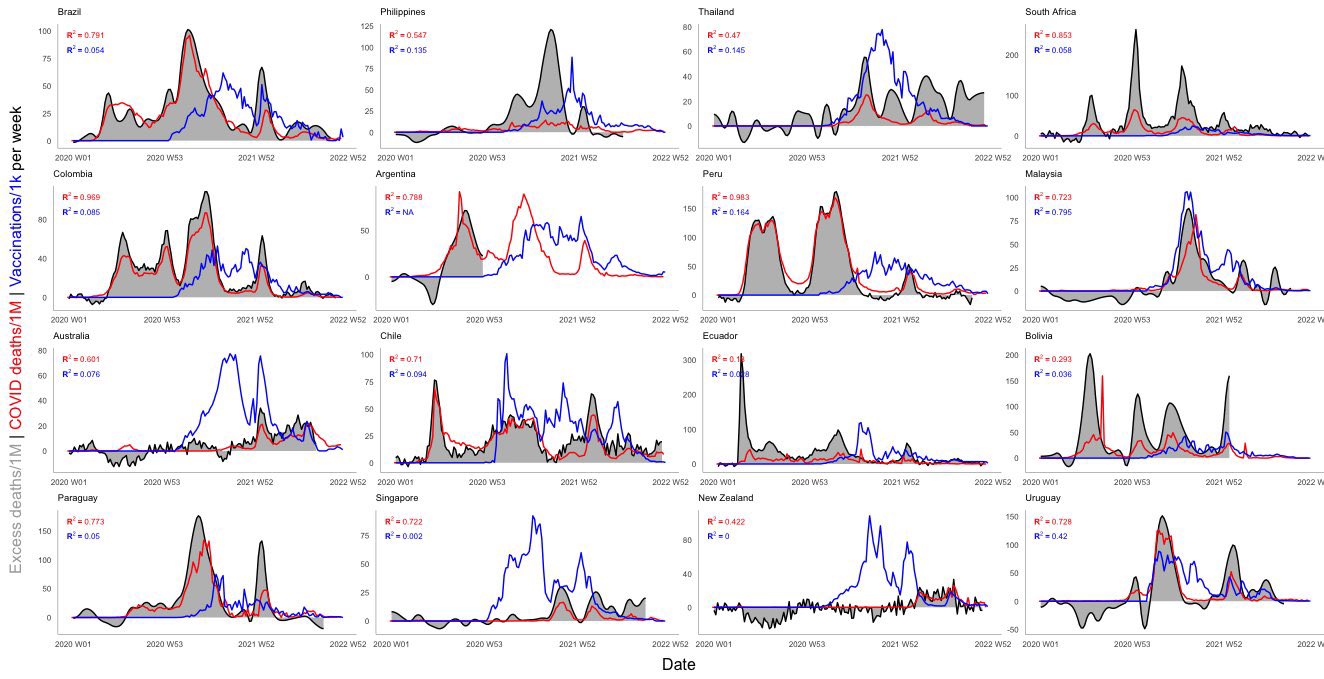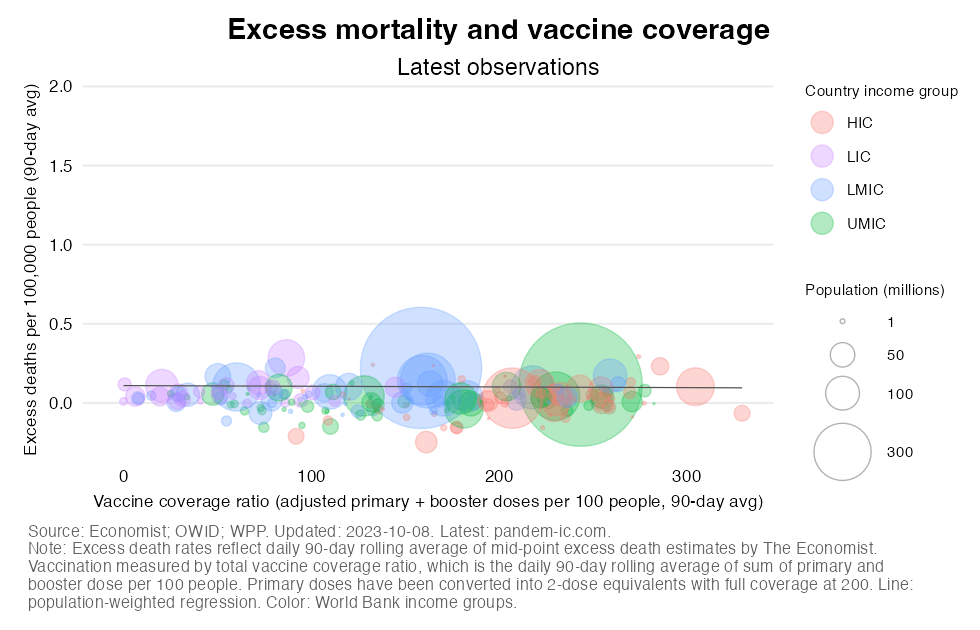
Unsupported: Published studies haven’t found that vaccinated people are more likely to experience a higher all-cause mortality compared to unvaccinated people.

FULL CLAIM: “Researchers Find COVID Vaccines Causally Linked to Increased Mortality, Estimate 17 Million Deaths”; “[T]here is no evidence in mortality that there was a particularly virulent pathogen that came onto the planet. There wasn't one. Then the vaccines were rolled out, and everywhere that they were rolled out, there was an increase in all-cause mortality.”
REVIEW
A claim that COVID-19 vaccines have killed 17 million people appeared in many social media posts on Facebook, Instagram, and X (formerly Twitter) in late September 2023.
The foundation for this claim is an analysis spanning more than 130 pages, co-authored by Denis Rancourt, a former professor of physics at the University of Ottawa. It was published on 17 September 2023 by the not-for-profit organization Correlation Research in the Public Interest, of which Rancourt is co-director.
Rancourt is also a member of Pandata, a group that was co-founded by South African private equity investor Nick Hudson in April 2020. The group has promoted COVID-19 denialism and vaccine misinformation. Rancourt has incorrectly claimed mask-wearing doesn’t work against COVID-19 and that “there was no pandemic”.
His analysis was disseminated through various outlets, including Rancourt’s X/Twitter account. The Epoch Times published an article on the analysis carrying the headline “Researchers Find COVID Vaccines Causally Linked to Increased Mortality, Estimate 17 Million Deaths”.
Rancourt also appeared in an interview with the World Council for Health, making the same claim. The World Council for Health, which has ties to Pandata, counts among its ranks individuals who’ve spread COVID-19 misinformation, such as Tess Lawrie and Peter McCullough.
However, the analysis by Rancourt et al. is highly flawed, as we will explain below.
What did the analysis do?
The analysis, titled “COVID-19 vaccine-associated mortality in the Southern Hemisphere”, examined all-cause mortality in 17 countries. The analysis claimed that all-cause mortality data didn’t indicate any benefit from COVID-19 vaccination.
The analysis attributed spikes in excess mortality before vaccines were rolled out to “sudden changes in medical and institutional protocols and government responses, tied to the declaration of a pandemic”, claiming that these deaths “cannot be due to a globally spreading viral respiratory disease”. Put simply, the analysis denied the fact that COVID-19 had caused a pandemic.
In addition, it claimed that all-cause mortality only began to rise after COVID-19 vaccines were deployed.
The authors arrived at this conclusion by calculating what it called the “all-ages vaccine-dose fatality rate (vDFR)”, which is the proportion of “inferred vaccine-induced deaths” to the number of vaccine doses delivered in a population.
Reading the analysis more closely, we can see that the authors’ method for quantifying vDFR essentially boiled down to measuring the extent of excess mortality during the period of vaccine rollout.
Rancourt et al. thus concluded that the overall vDFR for the 17 countries analyzed “would imply 17.0 ± 0.5 million COVID-19 vaccine deaths worldwide […] This would correspond to a mass iatrogenic event that killed (0.213 ± 0.006) % of the world population (1 death per 470 living persons, in less than 3 years), and did not measurably prevent any deaths”. It is this calculation that provides the basis for this claim.
Why is the analysis flawed?
Population-level analyses are relatively easy and quick to do, as the data is readily available. But it comes with lots of caveats. For example, one of the problems with this method is that the authors didn’t establish whether the people who died had been vaccinated, since their all-cause mortality data was population-level data, not individual-level data (ecological fallacy).
Establishing that the people who died had been vaccinated in the first place should have been an essential first step in the analysis. Without ascertaining that this is the case, we cannot reliably draw causal inferences between vaccination and death.
Eleanor Murray, an assistant professor of epidemiology at Boston University, told Forbes that ecologic studies “can be a valuable source of hypotheses in a crisis because strong individual-level effects can often be observed at the group-level. But it’s important to view these insights as temporary hypotheses that could likely be refuted as more data comes in”.
Jeffrey Morris, a biostatistician and professor at the University of Pennsylvania, questioned the validity of the conclusions by Rancourt et al. in a tweet. He pointed out that the spikes in excess mortality tended to line up with surges in COVID-19 deaths much more closely than vaccinations did (see Figure 1 below), yet the analysis didn’t acknowledge or consider COVID-19 as a possible explanation for the observed spikes in excess mortality.
Take for instance Peru (shown in Figure 1; second row, third column from the left), which clearly showed excess deaths (shaded in gray) lining up neatly with the spikes in COVID-19 deaths (red line).

Figure 1. The excess mortality in 16 of the countries analyzed by Rancourt et al. The gray-shaded areas mark excess deaths, the red line indicates the number of COVID-19 deaths per million people, and the blue line indicates the number of vaccinations per 1,000 people per week. Source: Jeffrey Morris (X/Twitter).
The spikes “don’t line up with strictness of Covid mitigation, and they don’t line up with vaccination rollouts (except in places when vaccination rollouts were done during massive Covid surges),” Morris wrote.
AFP News also tackled this claim in this fact-check. Experts it spoke to also concurred that the excess mortality was most likely due to COVID-19, not the vaccines.
Published studies don’t support the narrative that COVID-19 vaccines caused excess mortality
The inaccurate claim that excess mortality around the world is due to COVID-19 vaccination has been pushed repeatedly by anti-vaccine groups. Health Feedback refuted this claim in an earlier Insight article. The BBC, FactCheck.org, Full Fact, and AP News also covered the same form of claim.
Economist Philip Schellekens put together graphs correlating the level of vaccine coverage and excess mortality in various countries (see one example in Figure 2 below). These show that excess mortality wasn’t higher in countries with greater vaccine coverage compared to countries with lower vaccine coverage, and is inconsistent with Rancourt’s claim that COVID-19 vaccines are responsible for excess mortality.

Figure 2. A correlation of excess mortality per 100,000 people with the level of vaccine coverage, including primary vaccine doses and booster doses (as a proportion of the population). Source: Philip Schellekens.
Published studies so far contradict the narrative that COVID-19 vaccines increase the risk of all-cause mortality. A study that looked at excess mortality in the U.S. and other peer countries between June 2021 and March 2022 found that excess all-cause mortality was greater in the ten least-vaccinated states than in the ten most-vaccinated states[1].
A CDC study examining the period between December 2020 and July 2021[2] found that COVID-19 vaccine recipients had lower rates of non-COVID-19 mortality.
Another study in the state of Indiana, which included more than 520,000 people, compared vaccinated people with unvaccinated, previously infected people. The study actually found that all-cause mortality was 37% lower in the vaccinated group[3].
REFERENCES
- 1 – Bilinski et al. (2023) COVID-19 and Excess All-Cause Mortality in the US and 20 Comparison Countries, June 2021-March 2022. JAMA Network.
- 2 – Xu et al. (2021) COVID-19 Vaccination and Non–COVID-19 Mortality Risk — Seven Integrated Health Care Organizations, United States, December 14, 2020–July 31, 2021. Morbidity and Mortality Weekly Report.
- 3 – Tu et al. (2023) SARS-CoV-2 Infection, Hospitalization, and Death in Vaccinated and Infected Individuals by Age Groups in Indiana, 2021‒2022. American Journal of Public Health.


